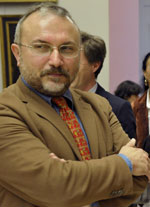Interview with Marc Favreau
Chief Curator at the Musée des Beaux-Arts and organiser of the exhibition
 By way of introduction to this exhibition, we need to remember the origins of this tapestry. It was the outcome of various different projects dating back to the 1640s, more precisely between 1640 and 1642, when Poussin came to Paris at the request of Louis XIII and Richelieu, and was appointed First Painter to the King. In this role he was commissioned to produce many pictures, altar paintings and in particular tapestries for the Crown. And after that date this involved transposing some of his own works, specifically a series known as the "Seven Sacraments", which then belonged to Roman patron of the arts Cassiano del Pozzo, and which Poussin had completed in the early 1640s. The project came to nothing because Poussin felt ill-at-ease. He was being mistreated by a group conspiring against him led by Simon Vouet, and furthermore Poussin did not feel very comfortable with copying works that he had already made. So he dragged his feet a little, and set this project to one side.
By way of introduction to this exhibition, we need to remember the origins of this tapestry. It was the outcome of various different projects dating back to the 1640s, more precisely between 1640 and 1642, when Poussin came to Paris at the request of Louis XIII and Richelieu, and was appointed First Painter to the King. In this role he was commissioned to produce many pictures, altar paintings and in particular tapestries for the Crown. And after that date this involved transposing some of his own works, specifically a series known as the "Seven Sacraments", which then belonged to Roman patron of the arts Cassiano del Pozzo, and which Poussin had completed in the early 1640s. The project came to nothing because Poussin felt ill-at-ease. He was being mistreated by a group conspiring against him led by Simon Vouet, and furthermore Poussin did not feel very comfortable with copying works that he had already made. So he dragged his feet a little, and set this project to one side.
But he did begin to work on another version of the "Seven Sacraments", drawing it for this commission for the royal tapestry. In the autumn of 1642 Poussin, growing weary of the demands of the French crown, returned to Rome and this first project came to an end. These initial drawings gave rise to the second series of "Sacraments", known as the Chanteloup "Sacraments", from the name of their owner. And this is where the episode of the relationship between Poussin and tapestry began. Chanteloup, who had received the drawings for this second version of the "Sacraments", later decided to pay himself for the transposition of Poussin’s paintings onto tapestry. He therefore approached a great Parisian tapestry weaver of Flemish origin, Hippolyte de Comans, who was then working on the site of the Hôtel des Gobelins, where several years later the royal manufacture would be established. Chanteloup commissioned an initial piece, entitled "The Order", but it soon became apparent that this piece did not offer all the technical qualities needed for the transposition of a painting into a woven medium. The experiment ended there.
The project was revived again in 1665 when Bernini arrived in Paris. In the carriage that brought Bernini, Chanteloup and Colbert from Saint Denis to Paris, Chanteloup again asked Colbert to transpose the works of Poussin, especially those based on the Sacraments. Colbert refused, because he felt that the techniques of tapestry in France were not yet sufficiently developed to capture all the nuances of Poussin’s painting, and render all their chromatic effects.
But it was no doubt the consequence of this insistence on the part of Chanteloup that he wished to see the works of Poussin reproduced in tapestry, that led Colbert and no doubt Le Brun also to agree to the project, the end result of which was "the Moses tapestry" that you now see here. We know that Colbert began to buy the works of Poussin for the king very early on, but the theme of Moses interested him for other reasons, notably because it was a foreshadowing of the defence of the true faith, with Moses as God’s champion on earth. It is now thought that Colbert instigated the project that would lead to the production in 1685 of 29 pieces of the 31 commissioned, although this runs counter to the tradition upheld by art historians up till now, which has it that Louvois, Colbert’s successor in 1683, instigated the project. It is probable that given the time the weaving would have taken and given the other commissions received by the Gobelins, the tapestry had been started during Colbert’s lifetime, and also at the initiative of Le Brun, who held Poussin in such high regard.
